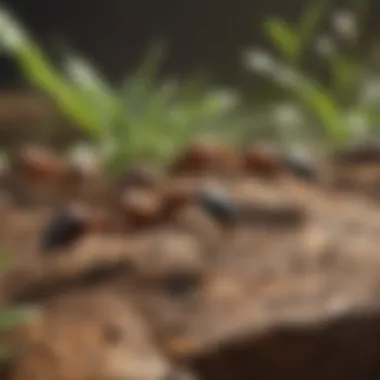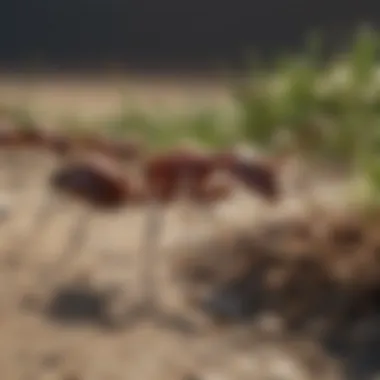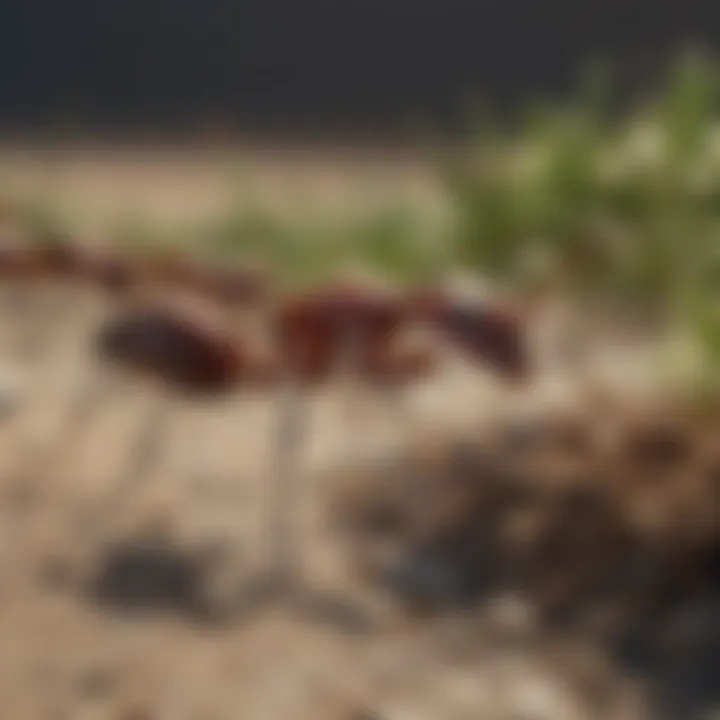Understanding Ant Invasions in Your Home


Intro
Ant invasions can be a frustrating experience for homeowners. Understanding the underlying reasons for these invasions and recognizing the species involved is key to effectively managing ant populations. This article provides valuable insights into ant behavior, identification, and eco-friendly prevention techniques. It also examines sustainable practices that can help reduce the impact of ants on our living spaces.
Understanding Pests
Pests can be defined as organisms that negatively affect human activities, particularly when they invade homes. Among these, ants are often seen as minor nuisances but can lead to significant damage if left unchecked. They have complex social structures and exhibit varied behaviors, which complicates control efforts.
Importance of Pest Identification
Identifying the specific type of ant is crucial. Different species have distinct behaviors, habitats, and preferences for food. For example, Carpenter ants are known for hollowing out wood for nesting, while Pharaoh ants are notorious for their ability to invade healthcare settings. Misidentification can lead to ineffective treatment strategies, resulting in prolonged invasions and increased frustration.
Prevention Techniques
Preventing ants from entering your home is more effective than trying to eliminate them once they have settled in.
Home and Garden Preventative Measures
- Sealing Openings: Inspect for cracks and crevices around windows and doors. Sealing these can reduce entry points.
- Proper Food Storage: Store food in airtight containers. This makes it harder for ants to detect food sources in your kitchen.
- Cleanliness: Regularly clean surfaces to remove crumbs and spills that attract ants.
- Yard Maintenance: Keep plants and trees trimmed. Overhanging branches allow ants easy access to roofs and eaves.
Seasonal Prevention Tips
Seasons influence ant behavior. In warmer months, ants seek food and nesting opportunities. Thus, homeowners should reinforce measures with these seasonal tips:
- During spring, check for new cracks due to shifting soil.
- At summer, ensure that outdoor food sources are managed properly.
- In winter, inspect for indoor moisture sources that attract ants.
Eco-Friendly Pest Control Solutions
Many homeowners are becoming increasingly conscious of the ecological impact of pest control. Thus, exploring sustainable practices is essential.
Overview of Sustainable Practices
Sustainable pest control focuses on long-term prevention and ecological balance. Tactics include monitoring ant populations and using least-invasive pest control measures. Educating oneself about local ecosystems can also help in developing effective approaches to pest management.
Natural Remedies and Their Effectiveness
Several natural remedies can mitigate ant invasions without the use of harsh chemicals. Common options include:
- Boric Acid: This can be mixed with sugar to attract ants while controlling their population.
- Diatomaceous Earth: This substance can be sprinkled around entry points. It disrupts ant exoskeletons and can be a barrier.
- Essential Oils: Oils like peppermint or tea tree can deter ants when used around the home. Be sure to dilute them appropriately before application.
Understanding the habits of ants and employing eco-friendly control methods can lead to sustainable pest management.
By being proactive, homeowners can manage ant invasions effectively. Recognizing the importance of identification and employing various prevention techniques will equip you with the tools needed for successful pest control.
The Issue of Ant Invasions
Ant invasions in residential settings are a considerable concern for homeowners. These small insects are not just a nuisance; their presence often signals deeper issues related to the environment, sanitation, and construction practices. Understanding why ants invade homes is crucial for effective management and prevention strategies.
Why Focus on Ant Invasions?
Ants can cause structural damage, particularly species like carpenter ants that excavate wood to create nests. They may also contaminate food sources, presenting health risks and leading to costly cleanups. Moreover, identifying and addressing these invasions early can prevent larger infestations that can become more difficult and expensive to manage later.
Understanding Ant Behavior
Ants are social insects that live in colonies. They possess complex behaviors and communication skills. Understanding their habits, such as foraging patterns and nesting preferences, is vital for determining why they enter homes.
Common Ant Species in Homes
Different species of ants are often found in homes, each with unique characteristics and behaviors that merit attention. Understanding these species helps homeowners tailor their prevention and control strategies.
Carpenter Ants
Carpenter ants are notable for their wood-excavating behavior. Unlike termites, they do not eat the wood but create tunnels for nesting. The key characteristic of carpenter ants is their size, which ranges from 1/4 to 1/2 inch long and often appears black or bicolored.
Their presence in homes can lead to significant structural damage over time if left untreated. Their ability to nest inside wooden structures makes them particularly harmful in areas where wood is exposed to moisture. Additionally, early detection can greatly mitigate damage, making this species relevant for homeowners.
Odorous House Ants


Odorous house ants are another common species found indoors. They emit a strong, unpleasant odor when crushed. This unique feature makes them easy to identify and a notable pest in homes. They are small, typically ranging from 1/8 inch in length, and can be brown or black.
These ants thrive in diverse environments, often invading kitchens in search of food. Their ability to form large colonies can create significant ant trails, complicating removal efforts. Understanding their behavior enhances the ability to control and prevent their presence.
Argentine Ants
Argentine ants are often identified by their small size and light brown color. They are highly social and prefer warm environments, making them well-suited for domestic settings. Their invasive nature and capacity to form supercolonies give them a unique advantage over other ant species.
This adaptability contributes to their rapid spread, making them a challenging pest for homeowners. Argentine ants can disrupt local ecosystems and exacerbate ant infestations. This characteristic highlights the importance of effective management strategies.
Identifying an Ant Infestation
Identifying an ant infestation is crucial for timely intervention and management. The sooner you recognize the signs of ant activity, the more effectively you can prevent further damage and disruptions in your home. Ants are social insects, and their colonies can grow rapidly, leading to larger infestations that may require professional assistance. By being equipped with knowledge about the signs of infestations and the types of ant activity, homeowners can take proactive steps to maintain a pest-free environment.
Signs of Ant Activity
Visible Trails
Visible trails are a hallmark of ant activity, serving as communication paths for worker ants. These frequently traveled routes connect food sources to the nest. Some species, like the Argentine Ant, create obvious trails that are easily spotted. Identification of trails allows homeowners to locate the source of the problem quickly.
Additionally, detection of these trails can lead to understanding the behaviors of the ant colony. This characteristic is beneficial for targeting intervention measures. However, trails may be fragile or may not always remain visible following clean-up efforts, making them unreliable at times.
Food Sources
Ants are primarily motivated by the search for food, and knowing their food preferences can aid in infestation detection. Common sources that attract ants include sugar, grease, and protein. If food remnants or improperly stored items are available, ants will invade. Finding an ant near food can serve as an immediate indicator of an infestation. Recognizing potential food sources is a popular method in ant identification because it focuses on preventative measures. However, reliance on this method alone may overlook hidden ant colonies, thus leading to incomplete management outcomes.
Nesting Areas
Nesting areas are crucial as they symbolize the heart of an ant colony. Many ants prefer hidden spaces such as inside walls, under floors, or in decaying wood. Recognizing signs of nests—such as frass or small dirt piles—helps in locating the ants' habitat. This specific aspect of identification is beneficial because once nests are located, effective control measures can be applied directly. Yet, nests can be difficult to find, especially in larger homes or those with multiple levels, complicating the identification process.
Types of Infestations
Understanding the types of ant infestations is vital in determining the most effective course of action. Infestations can typically be categorized into solo colonies and multi-colony issues, each presenting unique challenges to homeowners.
Solo Colonies
Solo colonies signify a single group of ants residing in one area. These infestations are often less complex and easier to manage. Identifying a solo colony can enable homeowners to implement targeted strategies quickly. This type of infestation is a beneficial focus in discussions about ant management—isolation of the colony can limit spread. However, misidentifying a solo colony may lead to assumptions about the extent of the problem, potentially resulting in inadequate responses.
Multi-Colony Issues
Multi-colony issues involve several nests contributing to a larger infestation. This situation often complicates management efforts. Identifying these cases is essential, as the presence of multiple colonies can lead to rapid reinfestation if not addressed comprehensively. Highlighting multi-colony issues is important in the context of understanding ant behavior and response strategies. The unique feature of this type of infestation allows for a broader analysis of ant dynamics. Nonetheless, the complexity of managing multiple colonies can be overwhelming for homeowners and may necessitate professional intervention to effectively address these challenges.
Causes of Ant Invasions
Understanding the causes behind ant invasions is essential for homeowners. This knowledge not only informs identification but also contributes significantly to prevention strategies. Ants do not invade without reason; they are highly sensitive to their environments. By knowing their triggers, one can make informed decisions to limit these pests. The focus here is on two primary categories: environmental factors and human influence. Awareness of these factors helps in formulating an effective response.
Environmental Factors
Seasonal Changes
Seasonal changes play a crucial role in ant activity. During warmer months, ants become more active as food becomes abundant. Their reproductive cycles peak, leading to increased indoor activity. The warmth encourages foraging and nesting, making it easier for them to enter homes. As temperatures drop, ants often seek shelter, which frequently results in invasions. This characteristic makes seasonal change a key focus in ant management strategies to anticipate and mitigate infestations during peak periods.
Urban Development
Urban development significantly alters natural habitats. The construction of new homes and commercial spaces disrupts ant colonies, forcing them to search for new nesting sites. This often leads to increased sightings in residential areas, where food sources are readily available. The influx of construction materials may also create attractive nesting areas for certain species. This unique feature of urban environments presents advantages, as understanding these changes allows homeowners to adapt their strategies effectively against invasions.
Human Influence
Food Sources and Storage
Human activity greatly influences ant behavior, especially regarding food sources. Improper food storage attracts ants, as they are driven by the smell of available sustenance. This factor can lead to a direct correlation between how food is stored and the likelihood of infestations. By recognizing that ants are opportunistic feeders, one can see the benefit of secure storage solutions. Addressing this aspect emphasizes the need for personal responsibility in controlling ant presence within homes.
Sanitation Practices
Sanitation practices directly impact ant invasions. Clutter and poor hygiene create ideal environments for ants to thrive. Trash left uncovered or crumbs on countertops provide easy access to nourishment. This situation highlights the crucial characteristic of maintaining a clean environment. Consistent cleaning practices can greatly reduce the chances of an infestation occurring. However, it is essential to understand that eliminating potential food sources requires effort, but it has significant long-term benefits in ant management.
Effective management of ant invasions is a combined effort involving both understanding their causes and proactive measures to prevent infestations.
Preventive Measures Against Ants


Taking preventive measures against ants is crucial for maintaining a pest-free home. Ants can infiltrate various areas of the house, from kitchens to living rooms, posing health risks and structural damage. The initial steps to prevent ant invasions require a good understanding of their behavior and habitats. If left unchecked, these pesky insects can form colonies and cause extensive problems.
Effective prevention not only reduces the likelihood of invasions but also minimizes stress and financial costs associated with pest control. Implementing a mix of chemical and behavioral modifications will yield significant benefits. Homeowners can enhance their environment's unwelcoming nature to ants, ensuring long-term protection against infestations.
Chemical Deterrents
Insecticides
Insecticides are a widely recognized solution for managing ant populations. They work efficiently by disrupting an ant's nervous system. A key characteristic of insecticides is their speed of action; homeowners can experience quick results after application. This immediacy makes them a popular choice in pest management.
However, insecticides come with their own unique features and must be used thoughtfully. Many formulations allow for indoor application, suiting the needs of households. Nevertheless, the disadvantages include potential health risks for humans and pets. Careful adherence to safety guidelines is essential.
Natural Repellents
Natural repellents offer a more eco-friendly alternative to chemical insecticides. These products often consist of plant-based ingredients that are more biodegradable and less harmful to humans and pets. A key characteristic of natural repellents is their ability to repel ants without necessarily killing them. This makes them an ideal choice for those who prioritize sustainability in pest management.
Some common natural repellents include essential oils like peppermint and tea tree oil. They can be applied around entrances or areas prone to ant activity. However, the effectiveness of natural repellents can vary. They might require more frequent applications, which could be seen as a drawback compared to traditional insecticides.
Behavioral Adjustments
Decluttering Spaces
Decluttering spaces plays an important role in pest prevention. Ants are attracted to clutter, as it can offer nesting sites and hiding spots. By regularly tidying up living areas, you effectively reduce the likelihood of ants finding suitable locations to thrive. This kind of proactive measure is simple yet highly effective.
A significant advantage of decluttering is that it improves overall home organization and cleanliness. A well-organized home creates an environment that is less appealing to pests. However, some individuals may find committing to regular decluttering challenging. Therefore, establishing a consistent cleaning routine is recommended.
Proper Food Storage
Proper food storage is another critical preventive measure. Ants are constantly searching for food sources, and improperly stored items can attract them. Ensuring food remains sealed in airtight containers can greatly diminish the chances of an infestation. This practice not only protects food from ants but also from other pests.
The unique feature of proper food storage is its simplicity and cost-effectiveness. Investing in quality containers is a one-time expense that can save significant money in pest control over time. On the downside, the effectiveness of this measure requires diligence in consistently storing food correctly to avoid potential weaknesses in your defense against pests.
Effective Control Strategies
Managing ant invasions requires a multifaceted approach. Effective control strategies focus on eliminating existing ant populations while preventing future invasions. This necessitates an understanding of both chemical and biological methods, along with ongoing management practices. Homeowners can benefit from these strategies through reduced infestation rates and overall improved pest management long-term. A combination of methods enhances effectiveness and minimizes risks associated with chemical treatments, making it crucial to explore each option thoroughly.
Chemical Control Methods
Indoor Sprays
Indoor sprays are a prominent choice for controlling ants within the home. These products often contain active ingredients like pyrethroids, which disrupt the nervous system of insects, ensuring their quick elimination. The key characteristic of these sprays is their ease of application. Homeowners can easily spray them in targeted areas where ant activity is noted, for example, along visible trails or near nests.
One unique feature of indoor sprays is their rapid action. From the moment of application, ants often exhibit immediate lethargy and eventually die. However, while they serve as a swift solution, there are notable disadvantages. The effectiveness can diminish if a colony is established, as it may not reach the queen or the entire colony.
Granular Treatments
Granular treatments present a different method of pest control. These consist of small pellets that can be spread across the ground or in areas where ants are active, such as near entry points. The key characteristic that makes granular treatments popular is their ability to provide a slow-release effect. This means that as ants forage and consume the granules, they transport the bait back to their colony, effectively contaminating more ants including the queen.
A unique feature of granular treatments is their versatility. They can be utilized both indoors and outdoors, depending on the specific formulation. However, one must consider the winding pathways that ants normally take. Granular methods might be less effective in areas exposed to rain, which can wash away the bait, reduce effectiveness, and create an unattractive mess.
Biological Control Approaches
Beneficial Organisms
Beneficial organisms include natural predators of ants, such as certain types of nematodes or insects. These organisms contribute to the overall ecological balance within the home environment. The key characteristic of using beneficial organisms is their sustainability as a control method. They offer a chemical-free way to manage ant populations, which resonates with environmentally conscious homeowners.
A unique feature of beneficial organisms is their prolonged effectiveness. Unlike chemical methods that may require frequent reapplication, these organisms often establish themselves in the ecosystem. Nevertheless, homeowners must be cautious in their implementation. These beneficial organisms could also affect other invertebrates present in the home ecosystem, which may not be desired.
Microbial Solutions
Microbial solutions employ naturally occurring bacteria or fungi that target ants specifically. These solutions contribute to pest management by infecting and eventually killing the ants that ingest them. The key feature of microbial solutions is their specificity; they affect ants without impacting non-target species. As a result, they are ideal for eco-friendly pest management, which is appealing to many homeowners seeking safer alternatives.
One unique aspect of microbial solutions is their long-lasting effects. Once introduced into the environment, the microbes can continue to spread and impact further ant populations. However, they demand careful handling. Their effectiveness may vary based on environmental conditions, and they typically require more time to show desired results compared to chemical methods.
The integration of both chemical and biological control strategies leads to a more comprehensive approach to managing ant invasions, maximizing effectiveness while being mindful of human and ecological health.
Long-term Solutions for Ant Management


Ant invasions in homes can be frustrating and challenging. Recognizing the importance of long-term solutions for managing these pests is crucial. These solutions do not just aim for a temporary fix but seek to create an environment that minimizes the chances of future infestations. Implementing thorough strategies not only protects your home but also balances pest control with ecological considerations.
Integrated Pest Management
Integrated Pest Management (IPM) is an effective approach that combines multiple strategies to control ant populations sustainably. It emphasizes understanding ant behavior and biology, which leads to more informed decisions.
Key components of IPM include:
- Identification: Knowing which ant species is invading your home. Different species have distinct behaviors and habitats.
- Monitoring: Regularly checking areas prone to infestations can help catch potential problems early.
- Prevention: This involves eliminating conditions that attract ants, such as food sources or nesting sites. Keeping a clean environment reduces the appeal for ants.
- Control: When necessary, a mix of chemical and biological control methods are employed. Utilizing targeted treatments minimizes the impact on non-target species and the environment.
Implementing an IPM strategy requires patience and effort. It is not a one-time solution, but a process that adapts over time based on observations and results.
Ongoing Monitoring Practices
Ongoing monitoring is essential in the long-term management of ant invasions. This practice ensures that any signs of new infestations are immediately addressed, minimizing the risk of larger issues.
Effective monitoring practices may include:
- Regular Inspections: Schedule routine checks around your home, focusing on entry points like doors, windows, and walls. Look for signs of ant trails or actual ants.
- Tracking Tools: Consider using sticky traps to monitor pest activity. These traps can provide valuable data on the presence of ants in specific areas.
- Record Keeping: Maintain records of inspections, findings, and any control measures taken. This information helps recognize patterns and informs future actions.
Through consistent monitoring, homeowners can develop a deeper understanding of the dynamics of ant populations. This insight allows for timely interventions and adjustments to preventive strategies.
"Long-term solutions for ant management are not merely reactive; they are proactive measures rooted in understanding and monitoring."
By employing these long-term strategies, homeowners can create a resilient environment that significantly reduces the risk of ant invasions while being considerate of ecological health.
Ecological Impact and Considerations
Understanding the ecological impact of ant invasions is crucial for homeowners aiming for effective pest management. Ants play an essential role in maintaining ecological balance. However, their presence in homes often raises concerns about potential damage and health risks. This section navigates the dual nature of ants in relation to ecosystems and residential spaces, informing readers about the benefits and challenges associated with their presence.
Role of Ants in the Ecosystem
Ants are often misunderstood and viewed solely as pests. In reality, they are valuable contributors to many ecosystems. Their primary roles include:
- Soil aeration: As ants burrow, they aerate the soil, allowing for better water penetration and root growth for plants.
- Decomposition: They help break down organic materials, contributing to nutrient cycling, which is important for soil health.
- Pest control: Certain ant species prey on pests, acting as natural pest regulators.
Ants also interact with other organisms. For example, they cultivate fungi as a food source and engage in mutualistic relationships with aphids. Their presence fosters a diverse ecosystem, supporting various life forms. However, when they invade homes, this positive role can be overshadowed.
Consequences of Eradicating Ants
Eliminating ants from a home may seem like an immediate solution, yet it can lead to unintended ecological consequences. Consider the following:
- Disruption of ecosystems: Removing ants can hinder soil health and affect the reproduction of native plants due to lack of aeration.
- Pest population surge: Without ants, certain pest populations may explode as their natural predators are removed.
- Loss of biodiversity: Some species that depend on ants for survival may decline, diminishing local biodiversity.
Therefore, while controlling ant populations within your home is necessary, it should be done thoughtfully. Implementing an integrated pest management strategy can help balance the need for control while preserving ecological integrity. Rather than relying on heavy chemicals, homeowners might consider safer alternatives that minimize impact on surrounding ecosystems.
"Nature does not hurry, yet everything is accomplished." - Lao Tzu
This quote reflects the importance of patience and understanding in managing ant populations. Taking a holistic view can ensure that homeowners protect their environments even as they address ant invasions.
The End and Final Thoughts
Ant invasions can be a significant concern for homeowners. Understanding the logistical patterns of ant behavior is not just academic; it has practical consequences for managing your living environment effectively. The insights provided throughout this article aim to equip individuals with the knowledge necessary to tackle infestations comprehensively. A well-rounded grasp of the key points discussed supports both immediate interventions and long-term management organized within the framework of ecological integrity.
By grasping the concept behind ant behavior and how diverse species may manifest in the home, you position yourself to take informed actions. The importance of ongoing monitoring cannot be overstated. It fosters a proactive mindset that significantly reduces the likelihood of return invasions. Recognizing infestations early allows for strategies that minimize damage and disruption, thus endorsing a more peaceful lifestyle.
In addition, considering sustainable pest control methods aligns with broader ecological considerations. Irrespective of the control methods chosen, it is crucial to reflect on the environmental impact resulting from those choices. Returning to a naturally balanced ecosystem after addressing pest issues is critical for overall health. Here, community involvement and awareness become essential for fostering environments where ant populations can be naturally managed.
Ant management is more than removing pests; it’s about maintaining a balanced home environment.
Summary of Key Points
- Understanding ant behavior enhances your response to infestations.
- Identification of common species aids in effectively addressing each situation.
- Preventive measures, like proper food storage and decluttering, can dissuade ants from invading.
- Control options, from chemical to biological methods, provide varied approaches to managing populations.
- Ongoing monitoring and integrated pest management shape long-term solutions and health.
Future Directions in Ant Management
As the landscape of pest control evolves, advancements in research and technology promise to change how we approach ant management. Future strategies may center on enhanced biological controls, focusing on specific beneficial insects that can mitigate ant populations without disrupting the overall ecosystem.
Moreover, developments in sustainable pest management techniques, such as pheromone traps or organic repellents, are likely to gain prominence. More homeowners are expected to prioritize ecological impact when selecting control strategies. This shift calls for education on new solutions and their applications in everyday life.
Another critical area may be community-driven pest management initiatives that emphasize collective action. Engaging local efforts can ensure a more significant impact on ant populations that are intertwined within community settings. Together, homeowners can devise plans that are not only effective but also environmentally sound.
In summary, the future of ant management will likely integrate technology, sustainability, and community efforts in progressive ways, providing homeowners with tools and techniques that align with both personal comfort and ecological responsibility.



